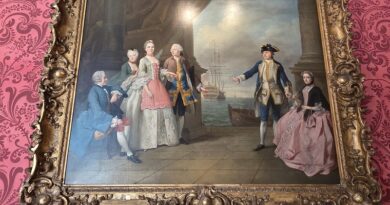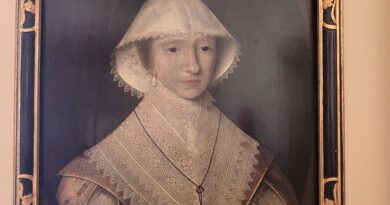Ickworth House – Frederick Augustus Hervey and the Grand Tour Theme
When we entered Ickworth House the friendly volunteer explained numerous things, including that they’ve got a theme this year of the Grand Tour and hence the decorative element in the main entrance hall. A little disappointingly, there’s nothing I can find on-line from the National Trust about this focus and the curation didn’t flow very well at the house either and they had put odds and sods around the place.
Going back, the driving force behind Ickworth House was Frederick Augustus Hervey (1730-1803), the 4th Earl of Bristol and Bishop of Derry. He was a little odd, or eccentric, whichever you prefer. On that theme, perhaps the most infamous anecdote illustrating his disregard for social and religious norms occurred in Siena. According to accounts, he deliberately threw a tureen of pasta from his hotel window directly onto a passing procession carrying the Host, the consecrated elements central to Catholic belief. The locals were not best pleased. As a more positive legacy, one of the Earl-Bishop’s most enduring legacies stems directly from his eccentric travel habits. His reputation as an epicurean and a demanding traveller, who insisted on the highest standards of comfort, cuisine and wine, became widely known across Europe. Consequently, numerous hotels seeking to advertise their quality and luxury began naming themselves “Hotel Bristol”, although there’s more on this theory at https://en.wikipedia.org/wiki/Hotel_Bristol.
Hervey owned Ickworth Lodge, which was really just a decadent farmhouse, but he wanted to create a country house with classical elements that would surprise and delight others. He declared that he wanted to “unite magnificence with convenience and simplicity with dignity, no redundancy, no superfluity, no one unnecessary room, but the necessary ones to be noble and convenient” which seemed an admirable aim.
The Earl Bishop travelled extensively across Europe, particularly focusing on Italy, and he wanted to move the Italian Neoclassical architecture to his Suffolk estate. Central to this was his engagement with the work of Italian architects, specifically Mario Asprucci the Younger (1764-1804). The Earl-Bishop had seen Asprucci’s work, most notably at the Villa Borghese in Rome, and commissioned him to provide designs for Ickworth. The commissioning of an Italian architect for a major English country house, based on direct experience of Italian models, highlights the cosmopolitan nature of elite architectural patronage during this period. It’s also why the house looks and feels like it does today.
But, it’s a fascinating theme for the National Trust to pursue, I’ve wondered before just how inspirational a grand tour across Europe must have been in the 1700s and 1800s.





